 Sichuan is famous for its noodles, and we recently traveled the area between Chongqing and Chengdu, following the Min River, to discover the best mian of region. Along the way, we visited Yibin and Leshan. While these two major cities that are known China-wide for their excellent noodle dishes, the stops along the river rewarded us with their own distinctive varieties of noodles that have joined our list of all-time favorites.
Sichuan is famous for its noodles, and we recently traveled the area between Chongqing and Chengdu, following the Min River, to discover the best mian of region. Along the way, we visited Yibin and Leshan. While these two major cities that are known China-wide for their excellent noodle dishes, the stops along the river rewarded us with their own distinctive varieties of noodles that have joined our list of all-time favorites.
The Landscape and Noodles of Chongqing
Chongqing is a spectacular city both by day and and at night. The city’s hilly geography, located at the confluence of Jialing and Yangtze rivers, has inspired and necessitated a distinctive urban style with residential and commercial buildings terraced along winding streets up the riverbanks.
Among Chongqing’s many gastronomic treasures Chongqing noodles, or xiaomian, stand out in Chinese culinary tradition. In its narrowest sense, xiaomian, literally “small noodles”, refers to vegetarian noodles with a fragrant broth made of onions, garlic and fermented bean paste, and a hot and numbing oil made with chili peppers and Sichuan peppercorns. More broadly, in Chongqing, the term may refer to similar noodles with other toppings such as stewed beef or pork ribs, but if you ask for xiaomian at a restaurant, they’ll assume you mean vegetarian noodles topped with green leafy vegetables.
Chongqing people are famed for their love of chilli peppers and Sichuan peppercorns, and demonstrate this love by even consuming mala (spicy and numbing) foods for breakfast. We joined the locals in enjoying xiaomian for breakfast, lunch and dinner during our stay. At each destination on our trip between the two cities, noodles were listed on the menu in three sizes:
- 一两 yiliang 50g
- 二两 erliang, 100g
- 三辆 sanliang 150g
To order a medium portion, ask for 二两小面 erliang xiaomian. Also throughout our trip restaurant proprietors followed our order with the question “Can you eat spicy food?”. When we confirmed that we could (可以!), they told us that “Yes, it’s much tastier when its spicy.”
Our Favorite Noodle Stops in Chongqing
Xiaomian from the the small Chongqing Xiaomian shop next to the tiny corner fruit shop at 10 Minzuxiang, Yuzhong District 渝中区民族巷10号1-1-号 (250m from Xiaoshizi Subway Station Exit 9). Open until 10pm.
And wandou mian (豌豆面), xiaomian with yellow peas on top and wanza mian (豌杂面), with both yellow peas and minced meat, from the Chongqing Xiaomian shop between Jiang Shi Zhengzong Chongqing Xiaomian姜氏正宗重庆小面 (another xiaomian shop) and the cigarette shop at 51 Jiuchikan Yuzhong District 渝中区九尺坎51号 (250m from Xiaoshizi Subway Station Exit 9). Open until 10pm.
Discovering Yibin: The Home of Burning Noodles
From Chongqing, we headed around an hour by train up the Yangtze River to the small city of Yibin, where the Min and Yangtze Rivers converge. Immediately upon exiting the train, we were hit by the fruity aroma of fermentation, which we first thought to be fermented tofu (furu). Moments later, we were reminded by advertising in the train station that Yibin is the home of Wuliangye (五粮液), one of China’s most famous brands of baijiu (distilled liquor).
Yibin is also famous for Yibin burning noodles (yibin ranmian, 宜宾燃面), which originated in the city during the Qing Dynasty (1644-1911) and have been added to Shichuan’s list of intangible cultural heritage. Known as burning noodles as they’re dry enough to catch fire, these traditional alkaline noodles are kneaded with less water than other noodles, then thoroughly dried after boiling so the sauce can adhere well.
The sauce is a fantastically flavorful mixture of fried and crushed peanuts, sesame oil, star anise, galangal, jingtiao chili peppers, Sichuan peppercorns and pickled rice spouts, a local specialty.
Our Top Sichuan Noodle Restaurant Recommendations in Yibin
Overall, we enjoyed the noodles most at Li Shi Liangpi and Yibin Ranmian (李氏凉皮 宜宾燃面), but we thought the sauce at Laozihao Tese Ranmian (老字号特色燃面), operated by the Lin family for over 30 years, richer and more flavorful. We thoroughly recommend both.
Li Shi Liangpi and Yibin Ranmian李氏凉皮宜宾燃面, 26 Xiaobei Jie, Cuiping District 翠屏区小北街26号 Open 7:30am until 10pm.
Laozihao Tese Ranmian 老字号特色燃面, on Zhongxiao Jie 忠孝街, 60 meters east of the intersection of Beixiaochang Jie and Zhongxiao Jie北校场街与忠孝街交叉口东60米. Open 6am until 9:30pm.
Leshan: Much More Than A Giant Buddha
We continued up river to Leshan, home to the 21-story-tall Leshan Giant Buddha, carved into the cliff above the river. The Buddha was carved there to protect the boats coming and going from what was then a busy river port, with the thriving trade that occurred there giving rise to a flourishing culinary scene that continues to this day. We estimate a seven to 10-day visit to Leshan would be necessary to try each of its specialty dishes, and focusing on noodles only, we still found ourselves with a packed schedule of eating.
Must-Visit Noodle Shops in Leshan: The Favorite
Our favorite noodles were Leshan’s pork rib noodles (paigu mian, 排骨面), shaozi noodles (shaozi mian, 绍子面) and MSG vegetarian noodles (weijing su mian, 味精素面), all local specialties.
To start, we recommend going to Liu Er Niang Zhengzong Weijing Su Mian (刘二孃正宗味精素面), located 100m northwest of the intersection of Chafang Jie and Chafang Lu 茶坊街与茶坊路交叉口西北100米, open 7am until 2am.
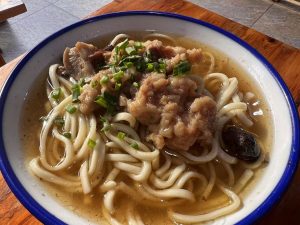
Weijing su mian (味精素面), literally MSG vegetarian noodles, were born in the 1980s, when MSG had just become available in China and was still an expensive luxury item. Inventors of the dish matched the level of 80s luxury by boiling the noodles in a carefully blended vegetable broth instead of water. During the cooking process, the noodles absorb the essence of the vegetables, adding lots of rich, mellow flavor that that receives a little push from the MSG. Topped with pickled vegetables and chilli oil, the result was good enough to rival the Giant Buddha as the primary reason to visit Leshan.
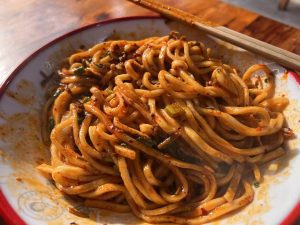
Not only was Liu Er Niang the number-one rated noodle shop in Leshan on China’s top review app, Dianping, but taxi drivers both on the way there and on the way back volunteered the opinion we’d found the best spot. However, despite this seemingly universal approbation, and our surprise and delight at the noodles we tried there, we managed to find a restaurant we liked even better.
Must-Visit Noodle Shops in Leshan: The Dark Horse
Wedged between touristy food stalls like a gap in a row of gold teeth, Zhengzong Weijing Su Mian (正宗味精素面) looks like the last surviving remnant of Old Leshan. And indeed, according to the sign out front, the restaurant has been in business for more than 60 years. It’s located at 39 Zhanggongqiao Jie 张公桥街39号 and open from 7am-3am.
The plain-looking but delicious weijing su mian at Zhengzong Weijing Su Mian, before and after mixing.
In our opinion the pork rib noodles, shaozi noodles and MSG vegetarian noodles we tried here all excelled those of the more famous restaurant and, although Yibin burning noodles may have been our favorite noodles of the trip, we were unanimous in agreeing the single best bowl of noodles came from this shop – we just couldn’t agree on which.
Chengdu: The Noodle Capital
Nearing the end of our trip, we took one final train up-river to Chengdu, home of Sichuan’s most famous noodles, dandan mian (担担面), and also the lesser known but much loved tianshui mian (甜水面), or sweet-water noodles. Dandan mian are named for the act of carrying the noodles on a shoulder pole. Purveyors of the noodles wandered the streets with a pole on their shoulder, with a basket of noodles hanging from one end and a basket of toppings hanging from the other. To make the topping, the chefs fry pork leg meat with oil and sweet flour paste (tianmianjiang, 甜面酱). Then they add cooking wine, chili peppers, Sichuan peppercorns, green onions and preserved vegetables.
If tianshui mian isn’t China’s thickest noodle, it must be close. Traditionally, each strand is as thick as a chopstick but we’ve also seen ones that are much thicker. The name of the noodles, literally “sweet water noodles”, comes from the heavy use of a sweet soy sauce, which gives the noodles a sweet flavor. Traditionally, chefs add chili oil, roasted sesame paste, sesame oil and mashed garlic as well as crushed peanuts on top.
Our Top Picks for Sichuan Noodles in Chengdu
We were lucky enough to get some insider recommendations from our team in Chengdu, who recommended one popular restaurant, located in a busy tourist street and so full that patrons were sharing tables, and one out-of-the-way shop full of local families. Though the pictures below show just how differently they prepare the noodles, we didn’t form a clear favorite between them. We recommend visiting both.
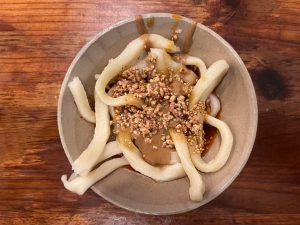
Xiao Ming Tang Tian Shui Mian Dan Dan Mian (小名堂甜水面担担面): 13 Dongchenggenshang Jie 青羊区东城根上街13号. 460m East of Renmin Gongyuan Subway Station Exit B. Open 9am-8pm.
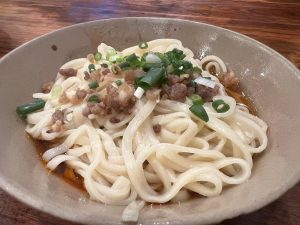
Dong Zi Kou Zhang Lao Er Liang Fen (Wen Shu Yuan Dian) (洞子口张老二凉粉 (文殊院店)): 39 Wenshuyuan Jie, Qingyang District 青羊区文殊院街39号. 450m northeast of Wenshuyuan Subway Station Exit K. Open.8:30am-6:30pm.
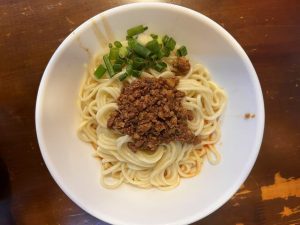
If you’re visiting Chengdu or Chongqing, we wholeheartedly recommend taking a short noodle journey of your own. With Chongqing, Yibin, Leshan and Chengdu each being just one hour apart by train, you can either take your time, visit these cities as day trips or, if you love noodles as much as we do, even eat breakfast, early lunch, late lunch and dinner in each city. If you are looking to find outstanding Sichuan noodles curated your own noodle expert, we also thoroughly recommend the Chengdu Classics Food Tour, which will have you snacking like a local within moments of meeting your guide.


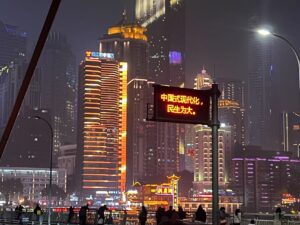
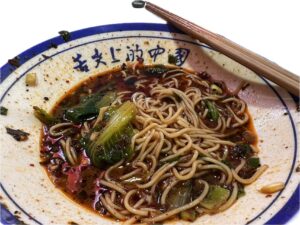


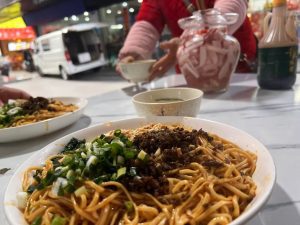
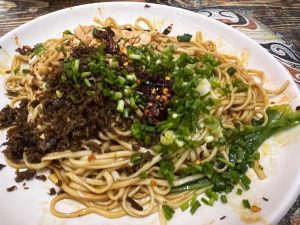
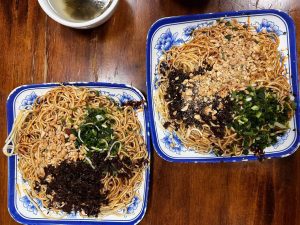

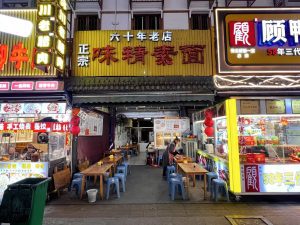
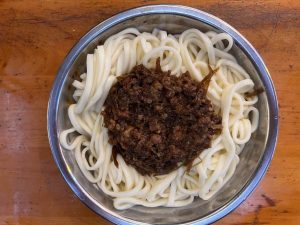
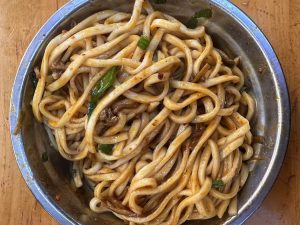
Leave a Reply